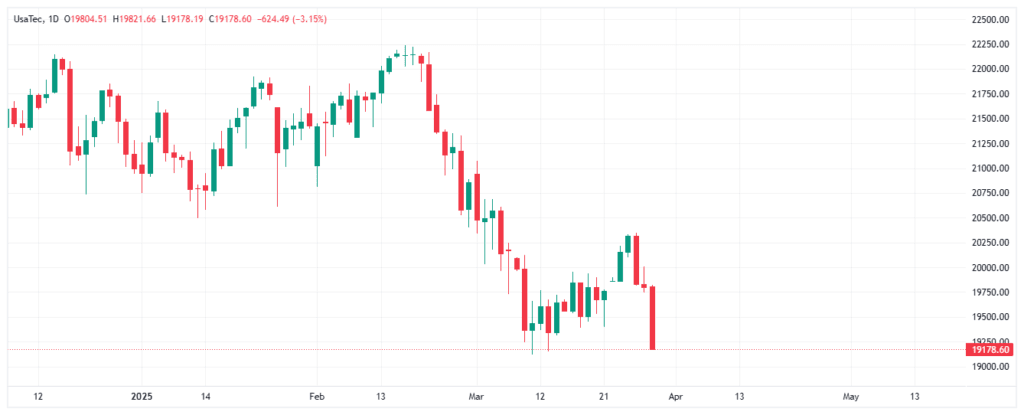The week ending March 28, 2025, showcased turbulent times for U.S. markets. Key indices faced significant losses as investors digested inflation data from the PCE Price Index and braced for the economic impact of tariffs on car imports taking effect next week. The S&P 500 dipped 1.5%, the Nasdaq decreased 2.6%, and the Dow Jones fell 1%. Meanwhile, consumer sentiment reached a two-year low, heightening fears of a slowing economy. Key company earnings added to market shifts, with notable movements in the retail and technology sectors. Here’s an in-depth analysis from the week.
| Index/Category | Weekly Performance (% Change) | Key Drivers/Factors | Notable Movers (Gainers and Losers) |
|---|---|---|---|
| S&P 500 | -1.5% | Inflation fears (PCE Price Index) and consumer sentiment dip | Gainers: Defensive healthcare stocks (e.g., Johnson & Johnson); Losers: Lululemon Athletica, retail sector |
| Dow Jones | -1% | Impact of impending car tariffs and weak economic data | Gainers: Stable industrial stocks; Losers: Ford, General Motors |
| Nasdaq Composite | -2.6% | Technology sector slump and earnings-related concerns | Gainers: Limited defensive tech stocks; Losers: Nvidia, Meta Platforms |
| Retail Sector | Significant decline | Shifting consumer spending and recession concerns | Losers: Lululemon, broader discretionary retail |
| Technology Sector | Decline | Earnings outlook adjustments, inflation challenges | Losers: Tesla, Microsoft, Nvidia |
Table of Contents
ToggleStock Market Performance for the Week
Overview of Key Indices
Each major stock index recorded losses for the week, fueled by economic and political uncertainties. The S&P 500 closed at 5,580.94, falling 86.62 points, or 1.5%. Similarly, the Dow Jones Industrial Average dropped by 1%, ending at 41,583.90. The Nasdaq, experiencing the sharpest decline among the indices, slid 461.06 points, or 2.6%, to end at 17,322.99.
The primary factors behind these losses include growing inflation fears spurred by the PCE Price Index’s release and anticipation of retaliatory tariffs on car imports. Analysts suggest these elements combined with weak consumer sentiment exacerbated the week’s market troubles.
Sectoral Breakdown
The technology sector was particularly hit hard. Heavyweights like Tesla and Microsoft declined, dragging down the Nasdaq. Retail stocks, highlighted by companies like Lululemon Athletica, also contributed to the downturn. The company warned of reduced revenue due to shifting consumer spending behavior, further reflecting broader concerns about inflation’s toll on discretionary income.
Technical Analysis
Dow Jones Industrial Average (DJIA)
The Dow Jones Industrial Average closed the week at 41,583.90, reflecting a sharp decline of 715.80 points or 1.69% on Friday. Technically, the index broke below its 50-day moving average, which now acts as a short-term resistance near 42,200. The next major support level is at 41,000, closely aligned with the 100-day moving average. The Relative Strength Index (RSI) has slid to 37, signaling momentum weakness as it approaches oversold territory. A developing head-and-shoulders pattern on the daily chart suggests potential further downside if the index fails to reclaim 42,500 in the near term. Traders should monitor any retest of the 41,000 support, as a breakdown could signal deeper corrections toward the 40,500 region. Volume analysis indicates rising selling pressure, pointing to bearish sentiment.

Nasdaq Composite
The Nasdaq Composite ended at 17,322.99, down 2.7% for the day and marking a challenging week for tech-heavy stocks. The index fell below its 20-day moving average at 17,800, with the next major support at 17,000. The RSI is at 34, nearing oversold conditions, suggesting limited downside unless broader market sentiment worsens. A bearish engulfing candle on the weekly chart strengthens the probability of further losses. If the 17,000 level holds, a bounce toward 17,800 is possible. However, a breach of 17,000 could lead to a retest of 16,500. MACD signals a bearish crossover, indicating weakening momentum. Tech earnings and macroeconomic announcements will heavily influence movements in the coming sessions.

S&P 500
The S&P 500 finished the week at 5,580.94, posting a 1.97% drop on Friday. The index is currently testing its critical support at 5,570, which aligns with its 50-day moving average. Below this level, key support lies at 5,500, a historically significant point for buyers. RSI has dropped to 38, reflecting bearish sentiment and nearing oversold levels. The daily chart shows a sequence of lower highs and lower lows, suggesting a continued downtrend unless the index regains the 5,620 resistance. A recovery above this level could signal bullish momentum, targeting the 5,700 zone. Conversely, failure to hold support at 5,570 may result in further selling pressure, with potential declines toward the 5,450 range. Volume spikes on down days hint at capitulation, making this a critical juncture for the index.

What Drove the Market Decline?
Inflation Concerns
The PCE Price Index data accentuated inflation risks, fostering fears of reduced consumer purchasing power and tighter monetary conditions. These dynamics weighed heavily on investor sentiment throughout the week, leading many to reassess risk exposure.
Impact of Trump’s Tariffs
Anticipation of automobile tariffs and potential reciprocal measures added to the uncertainty. With these tariffs set to begin on April 3, automaker stocks experienced noteworthy drops amid concerns over rising input costs. Ford and General Motors recorded declines exceeding market expectations.
Decline in Consumer Confidence
Consumer sentiment data revealed its lowest levels in over two years. Rising inflation and economic anxieties deterred liquidity in sectors dependent on discretionary consumer spending, like retail and travel. Markets faced an accelerated sell-off as confidence diminished by week’s end.
Significant Movers in Individual Stocks
Gainers
Amidst the broadly declining market, healthcare stocks like Johnson & Johnson managed to gain modestly. Investor interest in stable, defensive sectors provided a temporary cushion for these companies, limiting the broader market impact of negative sentiment.
Losers
Retail stocks bore the brunt of the downturn. Lululemon suffered double-digit percentage losses following revised revenue projections. Meanwhile, among tech companies, Nvidia and Meta Platforms recorded losses due to unfavorable earnings outlooks aligned with concerns within the broader sector.
Looking Ahead
Potential Market Reactions
Next week, markets will closely watch the tariffs implementation and potential retaliatory measures from trade partners. Additionally, any ripple effects from inflation data will likely shape Federal Reserve discussions.
Conclusion
The stock market’s performance over this critical week underlines an uneasy mix of economic pressures. Key indices saw noticeable dips, driven by inflation concerns, tariff anxiety, and waning consumer sentiment. With upcoming policy changes, markets may remain volatile in the short term as investors weigh risks and opportunities in light of evolving economic conditions. The stage appears set for cautious optimism pending further clarity.

















